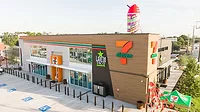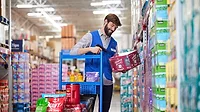Convenience stores continue to evolve
Consumers regularly redefine channel

Image courtesy of 7-Eleven
American rock band Green Day is on tour celebrating the 30th anniversary of their album “Dookie” and the 20th anniversary of the “American Idiot” album. Two songs off the album reference the convenience store 7-Eleven.
Earlier this year, Green Day launched their own coffee company: Punk Bunny Coffee. Twenty years after referencing 7-Eleven in their songs, Green Day’s coffee brand recently partnered with 7-Eleven, releasing a limited-time Anniversary Blend to commemorate 7-Eleven’s anniversary of “originating the idea of freshly brewed coffee in to-go cups,” as well as the anniversaries of Green Day’s two monumental albums, 7-Eleven shared.
“This year, we celebrate the 60th anniversary of 7-Eleven as the first national retailer to offer freshly brewed coffee in to-go cups, making us the OG To-Go coffee destination,” said Dennis Phelps, senior vice president of merchandising at 7-Eleven, in a statement. “What better way to celebrate than by teaming up with Punk Bunny to bring new and exclusive coffee options to our customers and offering a one-of-a-kind coffee experience?”
As convenience stores have become a staple of American culture, their efforts through collaborations as well as diverse product assortments shows how this channel is evolving to meet consumer trends.
That can be seen by the channel’s recent performance.

Jeff Lenard, vice president, strategic industry initiatives, at the National Associative of Convenience Stores (NACS), Alexandra, Va., says that convenience stores had record in-store sales in 2023 and that the average basket increased 3.7% to $7.80.
“The growth was led by foodservice,” Lenard notes. “Overall, total industry foodservice sales — which includes prepared food, commissary, and hot, cold and frozen dispensed beverages — represented 26.9% of in-store sales, up 1.3 percentage points in 2023 from the prior year.”
Lenard notes that profits from foodservice were more impressive at 37.3% of total in-store profits.
As for what consumer trends are contributing to that performance, Lenard says that c-stores look at consumer sentiment and economic conditions.
“Consumers are certainly in a better mood than they were a year ago, but that doesn’t mean they are feeling great,” he explains. “Inflation and other economic pressures have made some consumers cut back or reallocate spending. They are more likely to look for value, trading down ...”
This applies to specialty beverages as well, Lenard notes.
“Convenience stores sell immediate consumption and roughly 80% of the items purchased in a convenience store are consumed within the hour,” he says. “Market conditions — or perceptions about marketing conditions — can play an oversized role in how our sales are impacted, and it’s always something to keep in mind when building offers and market campaigns.”
In terms of specific beverage trends, Lenard states that c-stores are seen as destinations for beverages more than any other channel.
“More consumers come inside c-stores to purchase a beverage than any other reason,” he says. “The broader consumer trend for value also affects the cooler doors and beverage stations. Retailers are finding success by bundling offers and tying snacks or meals to beverage at the cooler doors.”
Technology also has played a big role in expanding the dispensed beverage offerings in convenience stores, Lenard notes.
Not long ago, he says that some fountain heads, a frozen dispensed product and a few coffee pots were “enough to compete” in the channel. Today, Lenard describes that it’s not uncommon to see multiple coffee programs and machines, along with smoothie machines and other options beyond the basics.
Convenience stores combine a small footprint with an extensive selection of beverages, making them a perfect destination for experimentation and trying new products, which is a huge market trend, especially when you factor in how they celebrate experimentation is social media posts.
“Finally, convenience stores combine a small footprint with an extensive selection of beverages, making them a perfect destination for experimentation and trying new products, which is a huge market trend, especially when you factor in how they celebrate experimentation is social media posts,” he says.
According to market research firm Mordor Intelligence, in its convenience store market report, there are a variety of factors contributing to the rise in sales at convenience stores. This includes changing consumer preferences, broadened product offerings, technology integration, effective promotional strategies and expanded social trends.
“Consumers are increasingly seeking convenience in their shopping experience, preferring quick and easy access to essential items,” the report states. “Convenience stores, with their extended hours and proximity to residential areas, cater well to this need. … Moreover, many convenience stores are now offering healthier food and beverage options, catering to the growing demand for nutritious choices.”
NACS’ Lenard highlights that convenience store operators are employing tactics to encourage consumers to enter the store beyond gas purchases.
“Roughly 80% of consumers fill up their tanks at a convenience store, and more than half of them (59%) go inside the store to make a purchase,” he explains. “That doesn’t mean that they are going inside the store because of some cue associated with purchasing fuel, although some do. Instead, the model has flipped from going to the store to get gas and maybe something else to going to other store for food and drinks and maybe fill up.”
Lenard says that consumer insights from NACS show that more consumers will drive five minutes out of their way to go to the store that they like than drive five minutes out of their way to save 5 cents per gallon.
“They are more likely to plan their gas purchase based on a beverage or food purchase than any other reason,” he adds. “But that doesn’t mean a competitive gas price isn’t important — it still is.”
Convenience stores are unique in their offerings, Lenard shares. Unlike other channels, he says convenience stores are less likely to be defined by the products they sell.
“Convenience stores sell a concept — convenience — that is constantly being redefined by consumers. The future of convenience is whatever the customer says it should be,” Lenard concludes.
Looking for a reprint of this article?
From high-res PDFs to custom plaques, order your copy today!






